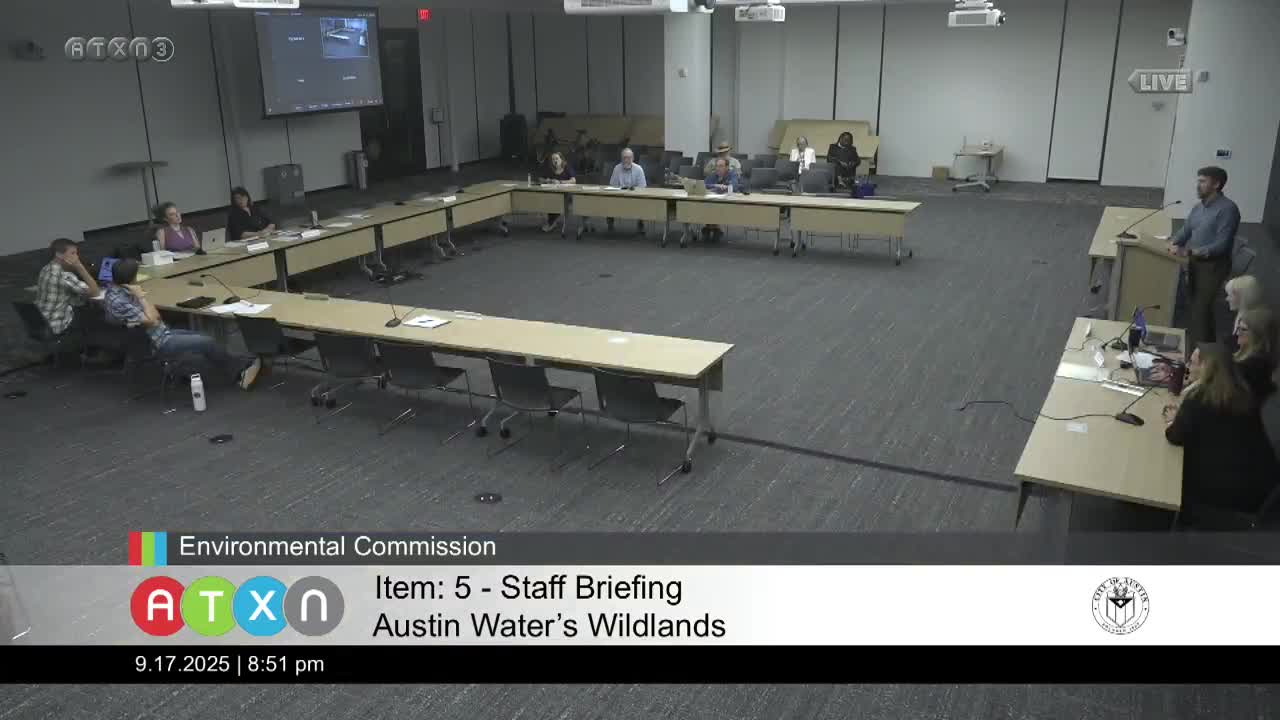Austin Water Discusses Land Acquisition Strategies for Conservation and Community Benefits
September 17, 2025 | Austin, Travis County, Texas
This article was created by AI summarizing key points discussed. AI makes mistakes, so for full details and context, please refer to the video of the full meeting. Please report any errors so we can fix them. Report an error »

In the heart of Austin, under the warm glow of city hall lights, members of the Environmental Commission gathered to discuss the future of the city's natural landscapes and water quality protection efforts. The meeting, held on September 17, 2025, highlighted the ongoing commitment to conservation and the challenges that lie ahead.
A key focus of the discussion was the management of the Maxwell Trail, part of the water quality protection lands. Officials emphasized the importance of closing trails during wet conditions to prevent erosion and protect the ecosystem. This approach reflects a broader philosophy of balancing public access with conservation values, ensuring that the natural beauty of Austin is preserved for future generations.
Commissioner Floyd raised questions about funding sources for land acquisition, particularly as the city aims to reach a goal of 50,000 acres of protected land. Recent acquisitions have been supported by general obligation bonds, with the 2018 bond providing $72 million for land purchases. Looking ahead, the 2026 bond presents another opportunity for funding, with recommendations for significant allocations toward water quality protection lands and the Balcones Canyonlands Preserve.
The conversation also touched on the interconnectedness of the community and the environment. Officials noted that half of the water quality protection lands extend into Hays County, emphasizing the importance of these areas for the entire region's water supply. Clean drinking water, they explained, is vital for all residents, particularly marginalized communities who are disproportionately affected by environmental changes.
As the meeting progressed, the complexities of partnerships among various organizations, including the Nature Conservancy and Travis Audubon, were discussed. These collaborations are essential for effective land management and conservation efforts. The commission acknowledged the need for clear communication about these partnerships to enhance public understanding and support.
A poignant moment arose when a commissioner highlighted the need for bilingual access to resources, particularly in the context of a new visitor center being developed by the county. The call for inclusivity resonated with the audience, underscoring the importance of making environmental education accessible to all community members.
As the meeting drew to a close, the commissioners reflected on the significant investments made in conservation over the past three decades. They recognized that these efforts not only protect the environment but also provide economic benefits to the community. The discussion served as a reminder of the delicate balance between growth and preservation, and the collective responsibility to safeguard Austin's natural heritage.
In a city known for its vibrant culture and commitment to sustainability, the Environmental Commission's meeting illuminated the path forward—one that embraces both conservation and community engagement, ensuring that Austin remains a place where nature and urban life coexist harmoniously.
A key focus of the discussion was the management of the Maxwell Trail, part of the water quality protection lands. Officials emphasized the importance of closing trails during wet conditions to prevent erosion and protect the ecosystem. This approach reflects a broader philosophy of balancing public access with conservation values, ensuring that the natural beauty of Austin is preserved for future generations.
Commissioner Floyd raised questions about funding sources for land acquisition, particularly as the city aims to reach a goal of 50,000 acres of protected land. Recent acquisitions have been supported by general obligation bonds, with the 2018 bond providing $72 million for land purchases. Looking ahead, the 2026 bond presents another opportunity for funding, with recommendations for significant allocations toward water quality protection lands and the Balcones Canyonlands Preserve.
The conversation also touched on the interconnectedness of the community and the environment. Officials noted that half of the water quality protection lands extend into Hays County, emphasizing the importance of these areas for the entire region's water supply. Clean drinking water, they explained, is vital for all residents, particularly marginalized communities who are disproportionately affected by environmental changes.
As the meeting progressed, the complexities of partnerships among various organizations, including the Nature Conservancy and Travis Audubon, were discussed. These collaborations are essential for effective land management and conservation efforts. The commission acknowledged the need for clear communication about these partnerships to enhance public understanding and support.
A poignant moment arose when a commissioner highlighted the need for bilingual access to resources, particularly in the context of a new visitor center being developed by the county. The call for inclusivity resonated with the audience, underscoring the importance of making environmental education accessible to all community members.
As the meeting drew to a close, the commissioners reflected on the significant investments made in conservation over the past three decades. They recognized that these efforts not only protect the environment but also provide economic benefits to the community. The discussion served as a reminder of the delicate balance between growth and preservation, and the collective responsibility to safeguard Austin's natural heritage.
In a city known for its vibrant culture and commitment to sustainability, the Environmental Commission's meeting illuminated the path forward—one that embraces both conservation and community engagement, ensuring that Austin remains a place where nature and urban life coexist harmoniously.
View full meeting
This article is based on a recent meeting—watch the full video and explore the complete transcript for deeper insights into the discussion.
View full meeting
